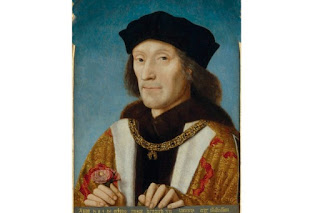Blog entry #7: Telling the Story of Early Modern England Using JSTOR: 7.8
On todays blog I chose to write about Henry VII, yes the father of Henry VIII, the first monarch of
the House of Tudor and the king who actually took initiative of England's internal and external
problems. Henry VII was born on January 28, 1457 at Pembroke Castle, United Kingdom. His reign on
England lasted 22 August 1485-21 April 1509. Unlike his spoiled corrupted son King Henry VIII,
Henry VII was a better king who outwitted his enemies using tactful manner and intelligence. He had
one goal for his country and Kingdom and that was transform it into a place of harmony, wealth, and
social success. Henry VII married Elizabeth of York and took part in the conflict between the
Lancastrians and Yorkists. The two factors that made King Henry VII have strong leadership of his
dynasty was his strength and financial position..."Two conditions which helped him establish his
dynasty and revive the efficiency of kingship were the strength and financial position (Kar,
Jasobanta. “HENRY VII : THE GREAT ADMINISTRATOR.” Proceedings of the Indian History
Congress, vol. 41, 1980, pp. 852–860., www.jstor.org/stable/44141913. Accessed 13 Nov. 2020).
Henry VII"s greatest strength was finance and revenue..."He had two sources of revenue one was
ordinary and the other one was extraordinary" (Kar, Jasobanta. “HENRY VII : THE GREAT
ADMINISTRATOR.” Proceedings of the Indian History Congress, vol. 41, 1980, pp. 852–860.,
www.jstor.org/stable/44141913. Accessed 13 Nov. 2020). One of the tactful plans Henry VII
conducted was combining the old ideas with new ideas to make his lands economy to prosper. As a result
he took England out of debt by taxing the rich, middle, and poor equally. Also, in return he promised the
taxpayers grants and loans whenever they were in need..."Thus crowns yielded $13,633 which rose
steadily and the receipt from the crown lands and wards' lands was $32,630 in 1504-5" (Kar, Jasobanta.
“HENRY VII : THE GREAT ADMINISTRATOR.” Proceedings of the Indian History Congress, vol.
41, 1980, pp. 852–860., www.jstor.org/stable/44141913. Accessed 13 Nov. 2020).
Also, during the Lancastrian and Yorkists conflict Henry VII led 5,000 men to battle on the Bosworth
field against Richard III and his 10,000-15,000 Yorkist troops. This was Henry VII's first and last military
career. Even worse he was unexperienced in battle due to him being exiled for so long in Wales and
France. However, he was victorious with the help of Sir William Stanley's back flanking Richard III's
troops while Richard III and his main force was focused on charging towards Henry VII and his troops.
Thus, the outcome was changed and Henry Tudor (VII) had the opportunity to slay Richard III face to
face while both their forces were busy battling each other. So Henry VII took the shot and killed
Richard III, now officially taking the name Henry VII from Henry Tudor and the title as king of the
York and Lancaster. Now with the new powers he achieved he managed to keep the peace between the
York and Lancaster by marrying Elizabeth of York (historyhit.com/facts-about-the-battle-of-
bosworth/Gabrielle Kramer). This is how Henry VII started establishing his dynasty through alliance
with Sir William Stanley, marriage with Elizabeth of York, knowledge of financing, earning his
people's respect, his dedication and persistency towards flourishing England was achieved that is until
King Henry VIII took the throne everything went dark.
Hyperlink Hyperlink Hyperlink Hyperlink



Comments
Post a Comment